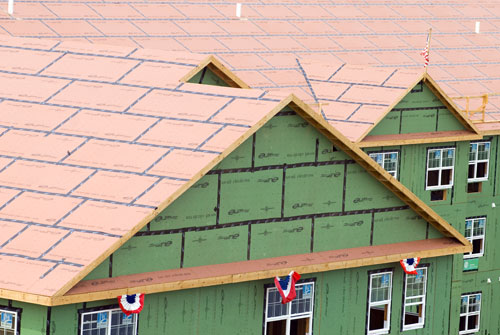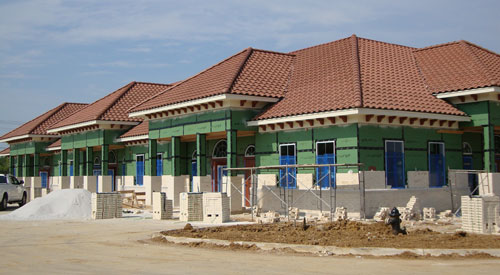High-Performance Wood-Framed Roofs
Combination Wood Structural Panel and Underlayment. Now available are wood structural panels with a built-in moisture-resistive barrier that eliminates the need for roofing underlayment. The easy to install roof panels do require that seams between panels be taped. This yields a structural roof system and code-recognized underlayment over which shingles and other approved roof coverings can be directly applied. These combination panels have a clear fastening guide on the panel surface for fast, accurate installation. Builders report a 40 percent reduction in installation time, which can potentially reduce the size of the roofing crew required, and renders the roof rough dried-in for up to 180 days. “With these panels, it was a quicker, easier process that got us watertight and kept our job moving.” says Trey Little, Project Manager at Nashville Builders Atkins and Associates.
 |
|
Photo: Huber Engineered Woods Wood structural panels with built-in moisture resistive panels install easily. |
Finished Roofing
The choice of finished roofing materials depends on cost, roof slope, expected service life, wind resistance, and local climate as well as aesthetics. Underlayment is a key factor in roof longevity, and underlayments that aren’t compatible with the roof-covering material can cause problems. The IBC stipulates the minimum type and application of underlayments to be used with each roof finishing material.
Asphalt Shingles. Affordable and durable, asphalt roofing shingles are the most widely used option in North American roofing applications. They tend to last longer in cool and dry conditions rather than warmer and more humid climates as extreme heat quickly damages and wears out the asphalt. Special ice-guard underlayments may be required in more northern climate zones. In extreme cold, shingles can develop hairline stress cracks. IBC requires two layers of felt underlayment in roofs with slopes between 17 and 33 percent, and one layer on steeper slopes; in roof areas prone to ice damming, the code requires at least two layers of underlayment cemented together or a self-adhering polymer modified bitumen sheet commonly referred to as ice-and-water membrane.
 |
|
Photo: Huber Engineered Woods Asphalt roofing shingles are the most widely used option in North American roofing applications. |
Clay, Slate, and Concrete Tiles. Slate is a natural material that doesn’t heat up, requires little maintenance, and can withstand major storms. Less expensive are clay tiles, which do well in southern climates and are suited to keeping out both heavy rains and radiant heat from penetrating into the building interior. Concrete tiles are also a popular choice in southern regions, and withstand colder conditions and high winds. The load carrying capacity of the roof should be checked to ensure it can handle the heavier weight of concrete tiles. For clay and concrete tiles, the IBC stipulates two layers of underlayment on roofs with slopes lower than 33 percent, and one on steeper roofs. For slate shingles, underlayment should comply with ASTM D 226, which covers 15 and 30-pound felt, or ASTM D 4869, for felt applications in steep-slope roofs.
 |
|
Photo: Huber Engineered Woods Clay tiles are typically used in southern climates and are suited to keep out heavy rains and radiant heat. |
Wood Shakes/Shingles. As long as wood shingles and shakes are from high quality wood like redwood, cedar and some treated pines they hold up well in most climates. Constant high heat however may cause cracking or splitting. A natural oil in cedar shingles helps repel water, making them ideal in climates with rain or humidity. The wood’s natural substance helps stop mold and mildew from rotting the shingle and causing leaks in the roof. For both wood shingles and shakes the code requires that underlayments comply with ASTM D 226, Type I or ASTM D 4869, and stipulates specific instructions in applying two layers of underlayment cemented together or self-adhering polymer-modified bitumen in ice dam prone areas. Wood shakes, in particular, need a heavy underlayment, and the code requires an interlayment to comply with ASTM D 226, Type 1. According to the Cedar Shake and Shingle Bureau, “The felt interlay acts as a baffle that prevents wind driven snow or other foreign material from entering the attic cavity during extreme weather conditions.”
Metal. According to the Metal Roofing Alliance, a metal roof can be expected to last at least two to three times longer than other roofs. While the initial cost may be significantly higher than an asphalt roof, the longevity and low maintenance requirements of a metal roof may result in a better per-year cost. Metal roofing has a 140-mph wind rating, and is able to withstand extreme weather such as high winds, heavy snow, hailstorms, and even wildfires. Ice and snow can easily slide off before building up and causing problems. However, people should be careful when walking under metal roofs with accumulated ice and snow. Metal panels do not provide much resistance to accumulations of ice and snow from sliding off on to the ground below. In hot climates, metal expands. The surfaces are fire-resistant and the metal is lightweight, and may also lower energy bills by reflecting the sun’s radiant heat away from the building. The IBC requires underlayment for metal roof shingles to comply with comply ASTM D 226, Type I or ASTM D 4869, and gives instructions for installing underlayment in ice-prone structures.









